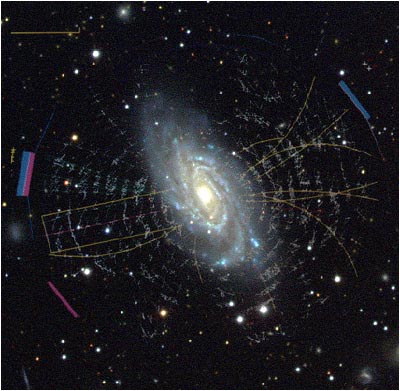 |
What is the Many Worlds Hypothesis? |
 |
What is the Many Worlds Hypothesis? |
Recent discoveries in quantum physics (the study of the physics of sub-atomic particles) and in cosmology (the branch of astronomy and astrophysics that deals with the universe taken as a whole) shed new light on how mind interacts with matter. These discoveries compel acceptance of the idea that there is far more than just one universe and that we constantly interact with many of these ´┐Żhidden´┐Ż universes.
Unfortunately, most books on the many-worlds hypothesis and quantum cosmology are written in language that an ordinary intelligent person cannot understand.
What is needed is an understandable source that explains the concept of the many-worlds hypothesis and its relationship to perceived reality´┐Ż´┐Ża source that brings together the contributions of such greats as:
Alain Aspect (the Aspect experiment)
John Stewart Bell (Bell's Theorem)
David Bohm
David Deutsch
Bryce DeWitt
Sir John Eccles
Albert Einstein
Hugh Everett
Stephen Hawking
Douglas Hofstadter
Fred Hoyle
Julian Jaynes
Sir James Jeans
Carl Jung
Subhash Kak
Sir Charles Lyell
Hermann Minkowski
Karl Pribram
Rupert Sheldrake
Neil Sloane
John Wheeler
What is needed is a source that makes clear the concept of the many-worlds hypothesis, multiple reality, the nature of the multiverse (or superuniverse), and the true meaning of Schrödinger's Cat and the two-slit experiment. Needed is a resource that explains in understandable, non-mathematical terms everything from the big bang hypothesis to morphogenetic fields.
Such a source exists.
John Stewart Bell, Bell's Theorem, Universe and Multiple Reality, Franks, Many Worlds, Many Worlds Hypothesis, Many-Worlds, Many-Worlds Hypothesis, David Bohm, M. R. Franks, David Deutsch, Bryce DeWitt, Sir John Eccles, John Eccles, Albert Einstein, Einstein, Hugh Everett, Stephen Hawking, Douglas Hofstadter, Universe, Multiple Reality, Multiple Realities, Hofstadter, Fred Hoyle, Julian Jaynes, Sir James Jeans, James Jeans, Carl Jung, Subhash Kak, Sir Charles Lyell, Charles Lyell, Hermann Minkowski, Minkowski, Karl Pribram, Rupert Sheldrake, Neil Sloane, John Wheeler, cosmology, parallel universes, parallel universe, what, what are parallel universes, quantum, physics, reality, multiverse, superuniverse, Schrodinger, Schrodinger's Cat, Schrödinger, Schrödinger's cat; two-slit, Big Bang, morphogenetic fields, Alain Aspect, Aspect Experiment, John Stewart Bell, David Bohm, David Deutsch, Bryce DeWitt, John Eccles, Albert Einstein, Hugh Everett, Stephen Hawking, Douglas Hofstadter, Fred Hoyle, Julian Jaynes, James Jeans, Carl Jung, Subhash Kak, Charles Lyell, Hermann Minkowski, Rupert Sheldrake, Neil Sloane, Karl Pribram, John Wheeler, The Universe and Multiple Reality, Universe and Multiple Reality, The Universe and Multiple Reality, Universe and Multiple Reality, book The Universe and Multiple Reality, Franks, M. R. Franks, Universe and Multiple Reality, Many Worlds, Many Worlds Hypothesis, Many-Worlds, Many-Worlds Hypothesis, The Universe and Multiple Reality, Universe, Multiple Reality, Multiple Realities, Universe and Multiple Reality, book, John Stewart Bell, Bell's Theorem, David Bohm, David Deutsch, Bryce DeWitt, Sir John Eccles, John Eccles, Albert Einstein, Einstein, Hugh Everett, Stephen Hawking, Douglas Hofstadter, Hofstadter, Fred Hoyle, Julian Jaynes, Sir James Jeans, James Jeans, Carl Jung, Subhash Kak, Sir Charles Lyell, Charles Lyell, Hermann Minkowski, Minkowski, Karl Pribram, Rupert Sheldrake, Neil Sloane, John Wheeler, cosmology, parallel universes, parallel universe, what, what are parallel universes, quantum, physics, reality, multiverse, superuniverse, Schrodinger, Schrodinger's Cat, Schrödinger, Schrödinger's cat; two-slit, Big Bang, morphogenetic fields, Alain Aspect, Aspect Experiment, John Stewart Bell, David Bohm, David Deutsch, Bryce DeWitt, John Eccles, Albert Einstein, Hugh Everett, Stephen Hawking, Douglas Hofstadter, Fred Hoyle, Julian Jaynes, James Jeans, Carl Jung, Subhash Kak, Charles Lyell, Hermann Minkowski, Rupert Sheldrake, Neil Sloane, Karl Pribram, John Wheeler